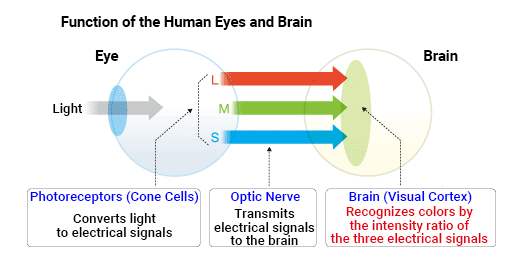Theory of Light and Color

11. Color (Part 1) Light and the Senses
All of the previous chapters have focused on the subject of light. We will now shift to the science of color within our greater understanding of light.
Many think an object has a unique color—a ripe strawberry is red, and a young leaf is bright green. In reality, only light and sight exist. Light is inseparable from color rather than being two different things.
Vision and Color
Light and sight (vision) are necessary to recognize colors.
The eyes detect light according to wavelength. The brain receives nerve impulses from the eye to recognize the color of the perceived light. The characteristics of the human eye and brain form our unique human vision ≪1≫. In a different sense, machine vision can also recognize wavelengths and their intensities.
Light as the Source of Color
We can see the color of an object because it reflects visible light into the eye. Without a light source, you cannot see an object, let alone its color. In other words, illumination is the source of color and a precondition for it to exist.

The Existence of Color: The Eyes and Brain
Light is the source of color, but color does not exist just because there is light. ≪2≫ Light is just physical energy until it enters the eye and is focused on the retina. The photoreceptors on the retina can perceive the energy of light. The light incident to the eye stimulates the photoreceptors, which send signals to the brain.

There are two types of photoreceptors. There are cone cells, which are sensitive to bright light, and rod cells, which enable vision in low-level light. ≪3≫
We can perceive color because of the cone photoreceptor cells. Cone cells can be classified into three types: S-cones, M-cones, and L-cones. They respond to visible light and respectively have a high sensitivity to short, medium, and long wavelengths. ≪4≫
These three types of cone cells send distinct signals via the optic nerve to the brain according to the different wavelengths. The brain is said to recognize color based on the duration and intensity of the signals from the three types of cones. It is only when the brain recognizes color that it exists.

Comment
≪1≫
Humans have acquired color vision because of evolution. The properties of color vision differ for each species. Therefore, animals other than humans live in a different world of color from the human world. Even among humans, it is impossible to confirm what colors people see, though it is possible to determine whether or not we can distinguish one color from another. Similarly, we cannot know what colors non-human animals can see. However, we can infer the color vision characteristics of various animals to some extent through studies of their photoreceptor cells and optic nerves.
≪2≫
Sir Isaac Newton summarizes this point in his book “Opticks”:
"For the Rays to speak properly are not coloured. In them there is nothing else than a certain Power and Disposition to stir up a Sensation of this or that Colour."
≪3≫
The cone cell is sometimes called a cone-shaped cell. Similarly, a rod cell is called a rod-shaped cell. These names are derived from the shape of each photoreceptor. The cone cell has a cone-like shape, and the rod cell has a rod-like shape.
≪4≫
The cone cells of the human eye are classified into three types: S, M, and L, based on their respective wavelength sensitivity properties (spectral response properties). S-cones have a high sensitivity mainly in short wavelengths, M-cones in medium wavelengths, and L-cones in long wavelengths.

